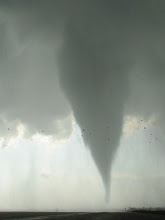Just a brief post for tomorrow's system. Looks like it could be an interesting day for the middle/lower MO river valley, at least by almost-still-the-middle-of-winter standards. Strong upper level trough crossing northern Baja this morning will eject negative tilt through the central Plains tomorrow. The associated surface low will seemingly have no trouble undergoing bombogenesis as it lifts NNE overnight tonight through tomorrow, potentially making a run at 982 mb by peak heating tomorrow. This isn't a classic Davies cold core set-up by any means, as the mid-level system (a negative-tilt shear axis) is not closed off... and will be moving at a high rate of speed. Showery precipitation, driven by strong high-level difluence/divergence preceding the upper trough, will spread through the middle and lower MO river valleys tomorrow morning. The potential for mini-supercells will follow in the warm sector of the surface cyclone (potentially initiating in the thermal ridge near a prefrontal confluence band), as the dry slot attempts to wrap northward and northeastward into the base of the negative-tilt trough. The farther north the dry slot can advance, the better, as my sense is that cells just to the cyconlic side of the mid-level jet will struggle to organize amidst 700-500mb flow of 50-80 kts, given SBCAPE will likely be AOB 500 J/kg. Respectable low-level CAPE (700 temps around -5C!) and healthy low-level shear (0-1km SRH potentially as high as 200-300 m2/s2) will aid in organization and the potential for mini-supercells and tornadoes. We've certainly seen past low-CAPE/super high-shear settings produce tornadoes (e.g. 11/12/05), but those cases seem pretty rare. Tomorrow's system has a huge bust potential, particularly if it races through the area more quickly and/or farther north like the GFS has been hinting at.
EDIT @ 930 P.M. : am liking the looks of the latest models even better. They continue the trend of mid-level dryslotting into the mid/lower MO river valley by early afternoon, heating the surface well into the 50s. Also, models actually bring dewpoints in the low 50s into the area--definitely looks at least possible given the deep (2 km), saturated boundary layer observed on the DDC and OUN RAOBs with ML dewpoints of 7-11C. Finally, the wind gradient in the cyclonic side of the mid-level jet is forecast to be far more diffuse, with non-outrageous 700-500mb flow (40-55 kts)... I'm actually seeing some semblences of a "warm sector" cold core pattern emerging.
Sunday, February 8, 2009
Subscribe to:
Post Comments (Atom)

No comments:
Post a Comment